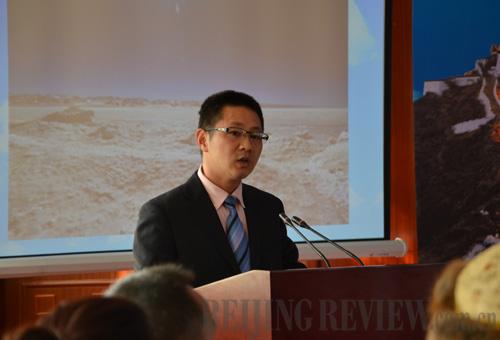|
 |
|
TIME FOR TIBET: Ma Jian, deputy chief of Lhasa City Tourism Bureau, makes a pitch for tourism in Lhasa during a promotional event for the "Winter Holiday in Tibet" travel package in Beijing on November 18 (LI FANGFANG) |
Just as a number of northern Chinese cities become enveloped in a winter haze, Tibet continues to shine with clear skies. Despite the sunny weather, however, potential visitors often express concern about the high altitude and low temperatures, especially in winter.
Amid the traveller confusion, Tibet Tourism Bureau announced its annual "Winter Holiday in Tibet" travel package in Beijing on November 18.
Ma Jian, deputy chief of Lhasa City Tourism Bureau, offered this description of Lhasa's atmospheric makeup during wintertime: The oxygen content there is 66 percent in summer, while it's 64 percent in winter; and as for the temperature, it reaches highs of 25 degrees Celsius in the daytime.
Meanwhile, the number of negative oxygen ions per cubic centimeter in Nyingchi Prefecture is 4,000-7,000, much higher than the normal concentration of 1,000-1,500 stipulated by the World Health Organization, according to Long Jun, representitive from Nyingchi Tourism Bureau.
Besides the comfortable air quality, visitors can also discover stunning views of holy mountain ranges, which are difficult to see in summer because of increased clouds. Some ethnic festivals are also celebrated in winter, including the Tibetan New Year's Day according to the Tibetan calendar, which falls on March 2, 2014.
Tourists generally prefer to visit Tibet in the summer. For the sake of improving winter tourism, the Tibet Tourism Bureau offers travel packages with nine themes, including Lhasa's sunshine, Mount Everest (also known as Mount Qomolangma), road trips in Nyingchi Prefecture and sacred weddings.
Since the "Winter Holiday in Tibet" was launched in 2007, the over-crowded state of summer tourism has been eased. The number of trips in winter of 2012 reached 1.79 million, making up 17 percent of the trips in the whole year. |
